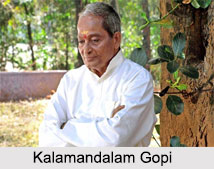 Vadakke Manalath Govindan Nair, popularly known as Kalamandalam Gopi is an advocate of the classical dance-drama style recognized as Kathakali. Kalamandalam Gopi was born in Kothachira village near Pattambi, Palakkad district in 1937. His original name was Vadakke Manalath Govindan. He debuted as Kusain Lavanasura-vadham i.e. "Slaying of Lavanasura". In 1951 he joined Kerala Kalamandalam and was a disciple of Vazhenkata Kunchu Nair, Ramankutty Nair, and Padmanabhan Nair for seven years.
Vadakke Manalath Govindan Nair, popularly known as Kalamandalam Gopi is an advocate of the classical dance-drama style recognized as Kathakali. Kalamandalam Gopi was born in Kothachira village near Pattambi, Palakkad district in 1937. His original name was Vadakke Manalath Govindan. He debuted as Kusain Lavanasura-vadham i.e. "Slaying of Lavanasura". In 1951 he joined Kerala Kalamandalam and was a disciple of Vazhenkata Kunchu Nair, Ramankutty Nair, and Padmanabhan Nair for seven years.
Early life of Kalamandalam Gopi
He started training in Ottan Tullal as a 9-year-old. He learnt Kathakali for about a year from Thekinkattil Ramunni Nair at Koodallur Mana. Born in 1937 in the village of Kothachira, Kerala, Kalamandalam Gopi (Vadakka Manalath govindan) was initiated in kathakali by Guru T.Ravunni Nair.
Career of Kalamandalam Gopi
Over a thirty-year career Kalamandalam Gopi has established himself as an outstanding Kathakali actor. He has played all major Kathakali roles, excelling as Bhima, Arjuna and Nala. The most notable representative of the Kalluvazhi School today, he has enriched the northern Kathakali style in many respects. He was on the teaching Kalamandalam Gopi as Raudra Bheemanfaculty of Kerala Kalamandalam from 1958 up to his retirement. For his eminence in dance and his contribution to its enrichment Kalamandalam Gopi received the Sangeet Natak Akademi Award in 1987. Kalamandalam Gopi became an instructor there in 1958.
He excels aspaccha heroes like Nala, Rukmangada, Arjuna, Kama, and Bhima, utilizing his height, perfect facial features, wide expressive eyes, and innovative actions. He also gives importance to the postures of characters. At times he crosses the limits of abhinaya in the intensity of expressions, but his sringara (erotic) rasa is of high quality. Admired for his simplicity and sincerity, Gopi is the most popular Kathakali actor in Kerala after Kalamandalam Krishnan Nair. In 1994 he retired from the Kalamandalam as principal.
Achievements of Kalamandalam Gopi
He is often referred to by his fans as Gopiyasan. He has received the award of Padma Shri and the Sangeet Natak Akademi Award. Gopi has also acted in a couple of Malayalam feature films like Vanaprastham and Shantham. Filmmaker Adoor Gopalakrishnan made a documentary film of Gopi, entitled Kalamandalam Gopi. This was shown at the International Film Festival of India in 2000 with the other festivals within India, in the West and in the Far East. Journalist Meena Narayan produced and directed a docu-fiction about Gopi in 2010. Titled Making of an expert, the documentary explores the development of Nair from childhood onwards.
Personal life of Kalamandalam Gopi
Kalamandalam Gopi retired from Kalamandalam in 1992, aged 55, after 36 years of tutorial service and now lives in Mundoor, a village 12 km north of Thrissur, with his wife and two sons. He is still demanding as a Kathakali artiste both in India and abroad.




















